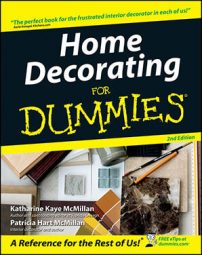One of the cornerstones of any home decorating project is choosing a color scheme. Color schemes exist for every taste. Use your color wheel to find the perfect color scheme. Some of the most popular and enduring schemes include
One-color neutral: Monochromatic (one-color) schemes come in two varieties. You can use a single color, or tonal variations of one color. Common schemes are based on white or beige, which can be very chic and quite contemporary. Make sure that all your whites and beiges are either cool or warm, and use texture and pattern (subtle ones such as wovens work well) to add interest.
White and beige tend to announce flaws loudly. Architectural imperfections (not to mention dirt and stains) may seem exaggerated. Hide flawed walls, for example, with a deeper value of beige.
Two complementary colors: The complementary color scheme contrasts colors that lie on opposite sides of the color wheel. Use proportionately more of one color to prevent too much tension. Use soft versions in neutralized shades, such as tan and slate.
Three-of-a-kind: The analogous color scheme uses three colors that lie close to each other on the color wheel. A typical scheme features one primary color plus two supporting colors (secondary or tertiary colors that lie on either side of the main color). For example, you can try red with a red-violet and a red-orange.
Three-of-almost-a-kind: The split-complementary color scheme harmonizes one main color with two colors that are adjacent to the complementary color (but not the direct complement itself). On the color wheel, draw an imaginary line from one main color to its complement. Select a color that is one space to the right of the complement, and then move one space to the left of the complement to find the second color.
Three-part harmony: The triad color scheme uses three colors the same distance apart on the wheel. Start with your main color and draw imaginary lines to colors that are equally spaced from the complement to form a triangle. Examples of triad color schemes are: red, yellow, and blue; and orange, green, and violet.
Four-part harmony: The tetrad color scheme ups the ante by featuring four equally spaced colors. Many Traditional color schemes are neutralized shades. These schemes are tricky to pull off, so base your own scheme on a fabric swatch, for example. Using coordinated upholstery and patterned fabrics makes the effort easier.

